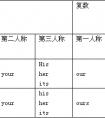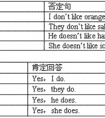根据句意及首字母(汉语)提示,补全单词。1. They have a____ their aim.2. Hard work is the key to s____.3. "Go for" is a____(短语)verb.4. Please c____to wor-九年级英语
-Yes,I have. I've just had it.
2.表示从过去某一时刻开始一直持续到现在的动作或状态。这个动作可能刚停止,可能仍然在进行。
常带有for和since等表示一段时间的状语。如:
He has taught here since 1981
他自1981年就在这儿教书。(可能还要继续教)
I have't seen her for four years.
我有四年没见到她了。
3.表示说话前发生过一次或多次的动作,现在成为一种经验,一般译为汉语“过”。
常与twice,ever,never,three times等时间状语。 如:
I have been to Beijing twice.我去过北京
4. 现在完成时还往往可以同包括现在时间在内的时间状语连用,如:
now,up to these few days/weeks/months/years,this morning/week/month/year,just,today,up to present,so far等:
Peter has written six papers so far.
Man has now learned to release energy from the nucleus of the atom.
There has been too much rain in San Francisco this year.
The friendly relations and cooperation between our two countries have been enhanced in the past few years.
Up to the present everything has been successful.
5.现在完成时往往同表示不确定的过去时间状语连用,如:
already(肯定),yet(否定,疑问),just,before,recently,still,lately,never等:
He has already obtained a scholarship.
I haven't seen much of him recently (lately).
We have seen that film before.
Have they found the missing child yet?
6.现在完成时的"完成用法"
现在完成时的"完成用法"指的是动作发生在过去某一时刻并已结束,但该动作对现在产生了影响,与现在情况具有因果关系。
例如:
He has turned off the light.他已把灯关了。(动作结束于过去,但说明的是现在的情况--灯现在不亮了。)
现在完成时"完成用法"的特点是动作不延续,因此:
该时态只能与表示不定的过去时间状语(如:already,yet,before,recently等)、频度时间状语(如:never,ever,once等)、包括现在时刻在内的时间状语(如:this morning / month /year...,today等)连用。
例如:Have you found your pen yet?你已找到你的钢笔了吗?
7.现在完成时的"未完成用法"
现在完成时的"未完成用法"指的是动作开始于过去某一时刻,一直延续到现在,或可能还要继续下去。
例如:
He has lived here since 1978.自从1978年以来,他一直住在这儿。
(动作起始于1978年,一直住到现在,可能还要继续住下去。)
I have been in the army for more than 5 years.我在部队已经呆了五年多了。
(动作开始于5年前,一直延续至今,有可能还要继续下去。)
此种用法的句中常需一个表示一段时间的状语(由since或for引导),或表示与现在时刻相连的时间状语(如:up to now,so far)等。
例如:
I have heard nothing from him up to now.到目前为止我没有他的任何消息。
注意:现在完成时的未完成用法只适用于延续性动词,不可用于终止性动词,即瞬间完成或延续时间很短的动词。
如:come,go,arrive,leave,join,become,die等。
8.一段时间+has passed+since从句
主语+have / has been+since短语
例如:He has been in the League for three years.
或It is three years since he joined the League. 他入团已三年了
9. 现在完成时常和短语 "up to now /till now","so far" (意思是从过去某一确定的时间一直延续到现在)连用。
Up to/till now he's read many story books. 至今他已读过好多故事书。
I've been to New York three times so far. 至今我已到纽约去过三次。
has gone (to),has been (to),has been (in) 的区别
has gone to:去了没回
has been to :去过
has been in:呆了很久
- 最新内容
- 相关内容
- 网友推荐
- 图文推荐
| [家长教育] 孩子为什么会和父母感情疏离? (2019-07-14) |
| [教师分享] 给远方姐姐的一封信 (2018-11-07) |
| [教师分享] 伸缩门 (2018-11-07) |
| [教师分享] 回家乡 (2018-11-07) |
| [教师分享] 是风味也是人间 (2018-11-07) |
| [教师分享] 一句格言的启示 (2018-11-07) |
| [教师分享] 无规矩不成方圆 (2018-11-07) |
| [教师分享] 第十届全国教育名家论坛有感(二) (2018-11-07) |
| [教师分享] 贪玩的小狗 (2018-11-07) |
| [教师分享] 未命名文章 (2018-11-07) |


![Sunday is my birthday. I would like _____ a birthday party, would you _____to my party? [ ]A. have; come B. to have; to come C. have; to come D. to have-七年级英语](http://www.00-edu.com/d/file/ks/4/2/budingshi/2020-01-08/smalla85122db0c71d7fb6ae58187be7f1fd11578430330.png)

![Why areyou here? You are supposed ______ in the classroom now. [ ] A. to studyB. to be studiedC. studying D. to be studying -九年级英语](http://www.00-edu.com/d/file/ks/4/2/budingshi/2020-01-08/small6dee02daa62cac1c71853ac804ab4fbd1578422460.png)
![She is very poor. Little food _____ and no room _____! [ ]A. to eat, to live B. to eat, to live in C. eating, living -八年级英语](http://www.00-edu.com/d/file/ks/4/2/budingshi/2020-01-09/small17b77c2697a3ef8f1461d0d14b016ee51578585185.png)
